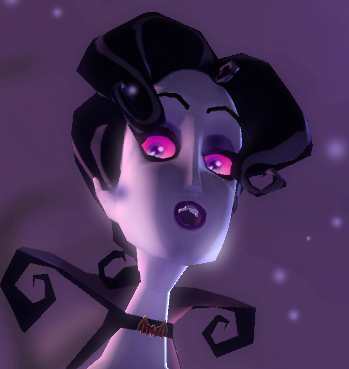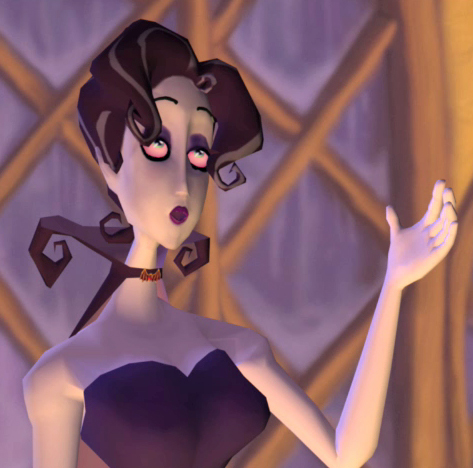Articles

A Vampyre Story Page One
Jesus, it's about time. It feels like we've been waiting forever for A Vampyre Story, and that would be because we have. Between this, Psychonauts and now Brütal Legend, it would appear that waiting 4-5 years for a game to come out is something the Mojo community should get accustomed to. But Bill Tiller’s latest is finally here, available both at retail and through digital distribution channels in a more or less simultaneous worldwide launch, one which missed Halloween by a mere month. Is the end result a modern classic, or is it merely eye candy? Read on!
The game's history bears mentioning, so a quick recap is in order for those who aren't familiar with A Vampyre Story or the people behind it. Its developer, Autumn Moon Entertainment, was founded in 2002 by Bill Tiller of LucasArts fame, perhaps best known as Lead Background Artist on The Curse of Monkey Island. While still under the employ of the Star Wars studio, he conceived of a graphic adventure chronicling the odyssey of a female vampire. Rather than pitching, and thereby forfeiting the rights to, his brainchild to a company that was clearly venturing away from the adventure genre quick fast and in a hurry, Tiller elected to hold onto his idea until he was in a position to make it a reality himself. Though it took striking it out on his own and several years of shopping a proof of concept to publishers (including that truly bizarre Bad Brain debacle back in 2005), the extended period of unfunded pre-production finally ended when Autumn Moon signed a deal with German based publisher Crimson Cow in mid-2006.
The project’s slow road to financial backing meant that we ended up knowing and seeing an unusual amount of A Vampyre Story well ahead of the commencement of true production – screenshots have been floating around the web for as long as four years, and some pieces of concept art are, as it turns out, actually of characters that get introduced in the sequel. If you haven't been tracking it along with us, the game tells the story of Mona de Lafitte, a hopeful opera singer from Paris who finds her pursuits sidetracked when she is kidnapped and rendered undead by the treacherous if rather pathetic Shrowdy Von Kiefer. The minikin vampire baron is smitten by Mona, but the feelings are less than reciprocated. In his boneheaded belief that she will grow to love him, Shrowdy keeps her captive in a tower in his ancestral home of Castle Warg, which lies deep in the frigid land of Draxylvania in the middle of a lake inhabited by a monster. As the game opens, Shrowdy gets a stake through the heart while on the hunt for fresh blood, thus supplying the long-imprisoned Mona with an opportunity to escape. Mona’s journey is abetted by a wisecracking bat named Froderick and burdened by her vampire state, which she is still coming to terms with. Being a creature of the night, however, is not without a few perks.

A Vampyre Story is a pure point ‘n click adventure game in the classic style. As the screenshots suggest, its gameplay model is very much The Curse of Monkey Island, which is not surprising since the two games share a number of team members. The game’s main selling point is naturally the gorgeous hand painted backgrounds (the work of Bill Tiller with help from Jean-Louis Sirois and another LEC legend, Bill freaking Eaken), which are alone worth the price of admission. Despite the comparisons it summons to the third Monkey Island, it must be said that the art direction of this game is distinct, with Tiller culling from a number of inspirations, most notably the illustrative style of Edward Gorey. (Apparently, Bill even flirted with the idea of doing the game entirely in black and white at one point. The color palette of the final game is too attractive for me to imagine it any other way, but, man, that would have been a brave and intriguing choice.)
Though A Vampyre Story’s environments come in the form of 2D backgrounds, they are not without some three dimensional enhancements. The gameplay assets - character and objects - are 3D models rather than sprites, likely to keep animators on a sane schedule. Not that the decision feels in any way like a compromise – the characters are wonderfully realized from their splendid designs (check some out in our concept art gallery), and the animation is expressive and top shelf. Sexing up the locales are some subtle but effective bells and whistles, such as falling snow and lovely foreground/background effects, all of which contribute to a truly spectacular visual presentation that is guaranteed to make you stop and gape throughout. Like its blood relative CMI, this is a game whose presentation relies almost entirely on the quality of its illustrated artwork and animation, which no amount of superficial gee-whiz can (nor needs to) improve in any substantial way. It's not hyperbole to suggest that A Vampyre Story is among the most beautiful video games ever, and if there is one aspect of the title that feels utterly flawless, the art is unquestionably it. While many adventure games share A Vampyre Story’s ambition to evoke the LucasArts golden age, this is a rare case where the caliber of the production values truly merits the comparison. In short, the visuals of this game are a knockout.

The audio side of things, as always seems to be the case with a LucasArts or LucasArts “offspring” game, is also superb. The sound production and direction was handled by Bay Area Sound (Jared Emerson-Johnson, Julian Kwasneksi), who do their usual great work here. The voice acting, a vital component of any modern story game, is uniformly solid, with the delivery being spot-on excepting a few quirks here and there. (For example, there's a conversation between Mona and a talking gargoyle during which Mona exclaims, “What?!” incredulously, whereas within the context of the conversation she really should have delivered the line as in, “What do you mean?”). An even more niggling complaint is that some minor timing issues negatively impact the dialog - there are a handful of cases where speech unintentionally overlaps or gets cut short. Overall, though, the sound design is one of this production’s biggest strengths. That the gripes I have about it basically boil down to it not being perfect is really a commentary on how high the bar of comparison – the later LEC classics and Telltale – is, though it should be said that we’re talking about the very guys who set that bar.
The quality of the performances has more than a little something to do with the fact that every last one of the characters is perfectly cast. You may even recognize a talent or two, as most of the performers have a Telltale game on their resume. Mona's giddy French-accented voice, provided by Rebecca Schweitzer, took me by surprise at first – after years of seeing sprites and models of her character, I was expecting more of a femme fatale than a shrill girly personality - but once you grasp the tone of the game, which is established pretty quickly, it works perfectly. The memorable and melancholy soundtrack, composed by Pedro Macedo Camacho, is excellent and well implemented, and adds a ton of atmosphere to a game already steeped in it. This is probably as good a time as any to mention that those who spring for the special edition of A Vampyre Story (unfortunately available only in Germany) get a soundtrack CD of the game's music among other extras.
Gameplay is, as mentioned, straight out of The Curse of Monkey Island. The clean and intuitive interface (here taking the form of a cross as opposed to a pirate medallion) is more or less identical, and reprises such tried and true conventions as the sentence line, an inventory accessible by right-click, and traditional dialog trees. While the game doesn't reinvent the wheel – it’s smart enough to know that it doesn’t need to - it does have a few interesting features up its sleeve. As a rookie vampire, Mona is still learning her powers. The ability to transform into a bat, which is useful for exploring locations inaccessible by foot, is available from the start as one of Mona's actions. More will be slowly acquired throughout her quest, and one assumes this arsenal will continue to accumulate in future installments.
Another unique feature of the game is the notion that inventory items can include both concrete and non-physical items, a concept which Bill has noted was borrowed from the cancelled Brian Moriarty version of The Dig. When Mona is directed to pick up an object of use that is too big to lug around until it is needed, the object will appear in her inventory with a blue glow, indicating that Mona is remembering the object for use later. It can then be used like any inventory object, and when it gets applied to whatever it ultimately needs to be used with, a brief sequence depicting Mona fetching the item will occur. Mona can store actions in her inventory in the same way; in one example, combining a shovel with a fire causes Mona to store the idea in her inventory, and only when the time comes that you find yourself in the market for a hot shovel will she actually dip the shovel in the flames.